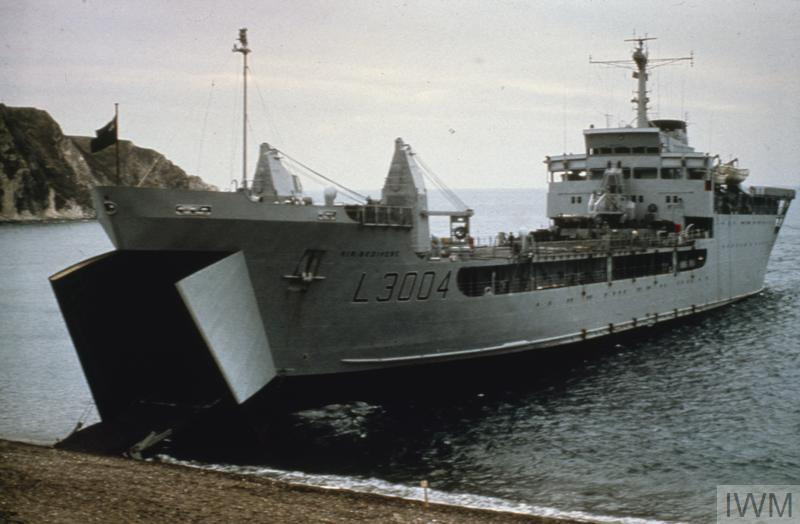Tuesday 27 April 1982 saw the departure from the UK of another task group, bound for the Falklands – North Sea trawlers taken up from trade which had been hastily formed up into the 11th Mine Countermeasures (MCM) Squadron.
The Argentine invasion of the Falkland Islands on 2 April had come at a rather awkward time for the Royal Navy’s minewarfare community.
Designed for shallow water and coastal work, the veteran Ton-class ships that formed the bulk of the MCM force at that time were regarded as being unsuited to the 8,000-mile ocean passage to the South Atlantic, and for loitering in the heavy seas that were regularly experienced around the islands.
But the new Hunt-class ships that were being built to replace the Tons were not yet quite ready for the task in hand – not least because there were only three of them in commission in April 1982, the third having joined the Fleet only at the end of March.
To fill what was potentially a crucial gap, an old Cold War plan was dusted off and five Hull-based North Sea trawlers were requisitioned for rapid conversion.
Cordella, Farnella, Junella and Northella, 1,600-ton trawlers of the J Marr and Son fleet, plus Pict of British United Trawlers fleet, were the five vessels, with Pict initially designated as a stores ship for the flotilla.
The ships were sailed to Rosyth in mid-April, where they were cleared of fish and preparations made for the fitting of basic – and vintage – minesweeping gear.
Members of their original crews, many of whom volunteered to man the trawlers all the way to the Falklands and into the heart of the conflict, stayed with the ships while their Royal Navy successors learned how to operate them.
The RN crews were taken mainly from Ton-class ships HMS Upton, HMS Wotton, HMS Bickington, HMS Soberton and HMS Bildeston.
The flotilla, by now commissioned, bearing HMS prefixes and making up the 11th Mine Countermeasures Squadron, sailed for Portland on 26 April where they finished fitting and testing the minesweeping gear, then sailed again on the following day, initially for Freetown in Sierra Leone, where the last few civilian members of the crew disembarked.
Pict left slightly later than the rest of the squadron, having been also converted to undertake minesweeping duties instead of simply carrying stores, and rendezvoused with the rest of the group in the Atlantic three days later, more than 100 miles off the coast of Portugal.
Also sailing on Tuesday 27 April was the sixth and final Landing Ship Logistics (LSL) RFA Sir Bedivere, having only arrived back at Marchwood on Southampton Water from Vancouver in Canada on Sunday 25 April.
After a quick training package from the Flag Officer Sea Training (FOST) team based in Portland, Sir Bedivere sailed south to join her sisters on Operation Corporate.
Over in South Georgia, British forces were tidying up on 27 April after the successful conclusion of Operation Paraquet to remove Argentine invaders.
Tanker RFA Tidespring had anchored in Cumberland Bay the day before to unload her passengers – Royal Marines of M Coy, 42 Cdo – and ammunition; the Royal Marines had been stuck out at sea with the tanker when South Georgia was retaken by fellow Royal Marines and special forces.
On Tuesday Tidespring embarked almost 190 Argentinian prisoners of war and Argentinian and Uruguayan civilians.
Out in the South Atlantic, the main Carrier Battle Group was still ploughing south through a third consecutive day of heavy seas, rain and high winds on Tuesday 27 April.
With the likelihood of armed clashes now far greater than the chances of a negotiated settlement, Battle Group commander Admiral Sandy Woodward, in his book One Hundred Days, recalls seeing the first signs of increasing tension on board his flagship HMS Hermes with medics reporting a third case of stress amongst the ship’s company.
Today’s image, from the extensive Imperial War Museum collection (© IWM CT 409) is of Landing Ship Logistics RFA Sir Bedivere.
* These posts can only give a brief sense of what was a complex and fast-moving situation 40 years ago, and cannot cover the involvement of every ship, squadron and unit in detail – for a much more comprehensive account see naval-history.net at https://www.naval-history.net/NAVAL1982FALKLANDS.htm
